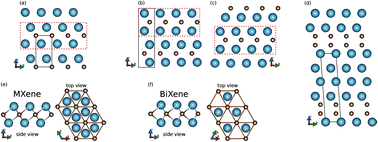A new 2D monolayer BiXene, M2C (M = Mo, Tc, Os)†
Abstract
The existence of BiXenes, a new family of 2D monolayers, is hereby predicted. Theoretically, BiXenes have 1H symmetry (P![[6 with combining macron]](https://www.rsc.org/images/entities/char_0036_0304.gif) m2) and can be formed from the 4d/5d binary carbides. As the name suggests, they are close relatives of MXenes, which instead have 1T symmetry (P
m2) and can be formed from the 4d/5d binary carbides. As the name suggests, they are close relatives of MXenes, which instead have 1T symmetry (P![[3 with combining macron]](https://www.rsc.org/images/entities/char_0033_0304.gif) m1). The newly found BiXenes, as well as some new MXenes, are shown to have formation energies close to that of germanene, which suggests that these materials should be possible to be synthesised. Among them, we illustrate that 1H-Tc2C and 1T-Mo2C are dynamically stable at 0 K, while 1H-Mo2C, 1T-Tc2C, 1H-Os2C, and 1T-Rh2C are likely to be stabilised via strain or temperature. In addition, the nature of the chemical bonding is analysed, emphasizing that the covalency between the transition metal ions and carbon is much stronger in BiXenes than in MXenes. The emergence of BiXenes can not only open up a new era of conducting 2D monolayers, but also provide good candidates for carrier materials aimed at energy storage and spintronic devices that have already been unveiled in MXenes.
m1). The newly found BiXenes, as well as some new MXenes, are shown to have formation energies close to that of germanene, which suggests that these materials should be possible to be synthesised. Among them, we illustrate that 1H-Tc2C and 1T-Mo2C are dynamically stable at 0 K, while 1H-Mo2C, 1T-Tc2C, 1H-Os2C, and 1T-Rh2C are likely to be stabilised via strain or temperature. In addition, the nature of the chemical bonding is analysed, emphasizing that the covalency between the transition metal ions and carbon is much stronger in BiXenes than in MXenes. The emergence of BiXenes can not only open up a new era of conducting 2D monolayers, but also provide good candidates for carrier materials aimed at energy storage and spintronic devices that have already been unveiled in MXenes.



 Please wait while we load your content...
Please wait while we load your content...